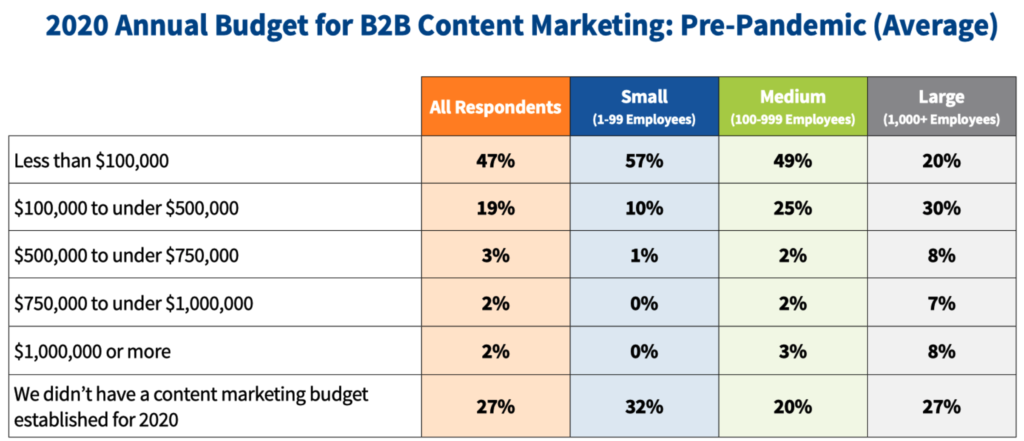Some companies reported a 600% increase in conversion by using content marketing strategically. Can you do the same?
In 2006, Hubspot started its business and only had 3 customers in its first year. By 2020, the company is on track to generate more than $800 million in revenue, boasting more than 85,000 customers. That is 34% more customers from the year before – an amazing growth at a time when COVID-19 was devastating and bankrupting businesses.
Core to its growth is Hubspot’s relentless content marketing strategy. The company believes that high quality content is more powerful and economical in acquiring and converting new customers. The company’s blog consistently attracts more than 320,000 visitors monthly with its free content. It’s even providing courses and certifications now. Their blog is one of the most important inbound channels for Hubspot generating thousands of new clients annually.
“If you compare inbound leads vs outbound, or paid, the types of things where you’re annoying people and kind of getting in their face… the conversion rate is more than double…for the organic leads, or the inbound leads.” – Mike Volpe, CMO of Hubspot
Hubspot’s made it look so simple. All you need is a blog and a bunch of writers, right?
Not so quick.
Hubspot’s success is a result of the company’s multi-year content strategy and execution consistency. On average the company posts around 5-7 blog posts daily. Additionally, these blog posts are supplemented with deep-dive white papers, how-to guides, webinars, and free tools such as website grader – giving their potential customers a comprehensive set of resources that help solve their problems.
That is quite a monumental task to tackle. And it’s fair for content marketers to argue that Hubspot is an almost billion dollar company with limitless resources for marketing.
But the company did not start that way. Its success really is driven by the company’s relentless consistency and focus on creating content that generates value for its customers.
Content is the only way to drive ROI continuously
When we engage customers through marketing, we are in effect building a relationship with them.
When ads appear next to your friend’s beautiful photos on Facebook and Instagram, they are there to get your attention. They are in fact competing with your friends in trying to build a relationship with you.
And many of these companies are very successful in doing so. They are, in fact, better at engaging with you than some of your social media friends.

The numbers speak for themselves. Companies with leading content marketing strategies generate 7.8x more traffic to their website versus their peers. And companies that leverage content marketing generate 6x higher conversion than those that do not.
Let’s use Hubspot again as an example. As discussed, content marketing is their primary channel to attract visitors. Mike Volpe, the Chief Marketing Officer of the company, attributes 75% of their leads to their content strategy which include content that ranges from blogs, white papers, calculators, survey forms to free templates.
It’s not just Hubspot that knows the power of content marketing though. In 2020, Content Marketing Institute surveyed more than 1,700 marketers globally and found that 26% of marketers spend $100,000 to more than $1,000,000 annually on their content strategies. Larger companies spend even more. If we look only at companies with more than 1,000 employees, this proportion swells to 53%.

Source: 2021 B2B Content Marketing: What Now?
In addition, B2B marketers are expected to spend even more on content in 2020. 30% of marketers globally are planning to increase their content marketing budget in the second half of 2020. This is in spite of the effects COVID-19. Many marketers cited that content marketing is more effective at generating ROI, and is a leaner option that produces results without significant reinvestment.
The floodgate of content has been opened
While content marketing remains strategic in many marketers’ arsenals, it is getting harder and harder to stand out.
The amount of information produced is estimated to reach 40 ZB in 2020 and will continue to increase exponentially. Content creation is no longer reserved to those with the means to do so as technology has democratised the process. The internet, smartphones with cameras, and increasingly intuitive software make it extremely accessible for people to be content creators.
WordPress powers around a third of all blogs on the internet and records 70 million blog posts monthly. Assuming other blogging sites produce similar volumes of content, that means humanity as a whole produces around 210 million blog posts per month!

And blogs only account for mostly written content. Videos and audios are becoming the default content format. Speedier internet and accessible data plans make this new format possible to be consumed at scale. Additionally, platforms such as Tiktok make it much easier for your regular Joe’s and Jo’s to create video content, increasing the overall volume of consumable content.
Tiktok alone accounted for hundreds of billions of video views online since its inception. In 2019, Tiktok users on Android devices spent 68 billion hours on the app. With that kind of engagement, it is no wonder more companies are using Tiktok to broaden their reach. Dunkin’ saw a 20% sales boost the day it started working with a 16-year old Gen Z Tiktoker.
People who have access to the internet spend almost 7 hours a week watching videos online. Oberlo estimates that by 2022, 82% of our bandwidth will be used to stream and download videos. Even professional social networking platform LinkedIn is putting videos front and center in their new release. As our civilization advances, we will only see more video content being produced.
Despite this, our ability to process information has not grown at the same rate. While content supply has increased exponentially, the amount of time available to us to consume remains capped. Yes, time spent on social media is still increasing, but only at a rate of less than 10% annually.
In absolute terms, we are already spending 153 minutes on average on social media daily, which is already a lot of time. However, there is a physical upper limit to our ability to watch, read, and listen to content. And we will definitely not be able to evolve our information absorption abilities fast enough to catch up with the exponential growth of content out there.
Standing out with content that adds value
Does that mean we should give up on this content stuff? Should we just focus on other marketing strategies like paid advertising?
Not really. As Seth Godin put it, “Content marketing is the only form of marketing left”. That’s a quote from 2008 but it still applies today.
As the number of interruptions and annoyances increase in our content feeds, what customers are looking for are content that truly add value. Not another invasive advertisement, and definitely not another click-bait headline that is not backed with solid content.
The only way to do that is to create content that actually solves your customers’ problems, delights them, and adds value to their lives. That is the only way you can build a great relationship with your customers and audience in a world that is so full of noise – ads or otherwise.
“Content marketing is the only form of marketing left” – Seth Godin
There is already increasing evidence that this is where content needs to go. Platforms such as Medium, Revue, Ghost, and Substack focus on helping people and companies (such as The Dispatch) generate super high quality content. They also make it much easier for consumers to choose whose content they want to consume, but also to reward those creators directly through paid subscription.
Your typical consumers are increasingly more interested in filtering and curating their own stream of content, rather than letting third parties do that on their behalf. More solutions are helping individuals better control the content that goes into their closely-guarded email inbox, the holy grail for many content marketers.
Content is one of the most powerful ways to convey what your company and products are about to the masses. It is a lever to drive your topline and bottom line, and also a great way to build a relationship with your customers. As the attention economy becomes more competitive, it is key to focus on content that not only provides instant gratification, but ones that imprint on your audience by being truly valuable.








